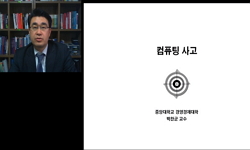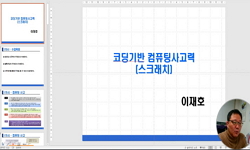본 연구에서는 퍼즐 기반 학습에서 이루어지는 초등정보영재의 컴퓨팅적 문제 해결 접근법을 분석함으로써 퍼즐 기반 학습의 체계적 개선을 위한 시사점을 도출하고자 하였다. 이를 위해, ...
http://chineseinput.net/에서 pinyin(병음)방식으로 중국어를 변환할 수 있습니다.
변환된 중국어를 복사하여 사용하시면 됩니다.
- 中文 을 입력하시려면 zhongwen을 입력하시고 space를누르시면됩니다.
- 北京 을 입력하시려면 beijing을 입력하시고 space를 누르시면 됩니다.

퍼즐 기반 학습에서 초등정보영재의 컴퓨팅적 문제 해결 접근법 분석 = The Analysis of Informatics Gifted Elementary Students' Computational Problem Solving Approaches in Puzzle-Based Learning
한글로보기https://www.riss.kr/link?id=A101701556
- 저자
- 발행기관
- 학술지명
- 권호사항
-
발행연도
2014
-
작성언어
Korean
- 주제어
-
등재정보
KCI등재
-
자료형태
학술저널
- 발행기관 URL
-
수록면
191-201(11쪽)
-
KCI 피인용횟수
3
- DOI식별코드
- 제공처
-
0
상세조회 -
0
다운로드
부가정보
국문 초록 (Abstract)
본 연구에서는 퍼즐 기반 학습에서 이루어지는 초등정보영재의 컴퓨팅적 문제 해결 접근법을 분석함으로써 퍼즐 기반 학습의 체계적 개선을 위한 시사점을 도출하고자 하였다. 이를 위해, 제약조건, 최적화, 확률, 통계, 패턴인식, 전략의 6가지 유형별 교육용 퍼즐을 구성하고 초등정보영재를 대상으로 퍼즐 기반 학습을 수행하였다. 또한 각 퍼즐 유형에 따른 학습자의 문제 해결 접근법을 확인하기 위해 사전 사후검사 결과의 정답률 및 정답자와 오답자의 문제 해결 접근법을 비교 분석하였다. 연구 결과, 각 퍼즐 유형별 빈번한 오류 발생의 원인인 몇 가지 양식 오류와 다양한 직관들을 확인하였으며, 오답자들은 '백트래킹', '동적 프로그래밍', '추상화', '모델링', '문제 축소'와 같은 컴퓨팅적 전략을 적용하지 못함으로 인해 완전한 해법에 도달하지 못한다는 것을 확인하였다. 이러한 분석 결과를 토대로 퍼즐 문제 표현 방식의 개선, 인지적 피드백의 적시 제공, 퍼즐 기반 학습 지원을 위한 웹 기반 시스템 개발 등 퍼즐 기반 학습 개선 방안을 제안하였다.
다국어 초록 (Multilingual Abstract)
The purpose of this study is to propose strategies of puzzle-based learning for Informatics gifted education through analyzing Informatics gifted elementary students' computational problem solving approaches in puzzle-based learning contexts. Six type...
The purpose of this study is to propose strategies of puzzle-based learning for Informatics gifted education through analyzing Informatics gifted elementary students' computational problem solving approaches in puzzle-based learning contexts. Six types of educational puzzles, which are constraints, optimization, probability, statistically speaking, pattern recognition, and strategy, were used in teaching 14 Informatics gifted students for 8 sessions. The results of pre and post test and each students' answers were analyzed to identify why students were not able to solve the puzzles. We also analysed what essential computational strategies are needed to solve each type of puzzles, and what students did not know in solving puzzle problems. We identified some problems caused by puzzle representation methods, and various students' intuitions that disturb puzzle solving. Also, we identified essential computational strategies to solve puzzles: backtracking, dynamic programming, abstraction, modeling, and reduction of big problem. However, students had difficulties in applying these strategies to solve their puzzle problems. We proposed the revised puzzle-based learning strategies, which is based on the improved problem representation, just-in-time cognitive feedbacks, and web-based learning system.
참고문헌 (Reference)
1 최정원, "초등정보영재 교육을 위한 퍼즐 기반 학습 가능성 탐색" 한국컴퓨터교육학회 16 (16): 9-16, 2013
2 J. J. Lu, "Thinking about computational thinking" 2009
3 U. Thomas, "The crossword puzzle : An aid to learning" 12 (12): 79-86, 1979
4 J. E. Pretz, "The Psychology of Problem Solving" Cambridge University Press 3-30, 2003
5 T. D. Crute, "Sudoku puzzles as chemistry learning tools" 84 (84): 612-613, 2007
6 NAS, "Report of a workshop on the scope and nature of computational thinking" National Academies Press 2011
7 N. J. G. Falkner, "Puzzle-Based Learning: The First Experiences" 2009
8 N. Falkner, "Puzzle-Based Learning for Engineering and Computer Science" PP (PP): 20-28, 2010
9 Z. Michalewicz, "Puzzle Based Learning: Introduction to critical thinking, mathematics, and problem solving" Hybrid Publishers 2010
10 Department for Education, "National curriculum in England: computing programmes of study"
1 최정원, "초등정보영재 교육을 위한 퍼즐 기반 학습 가능성 탐색" 한국컴퓨터교육학회 16 (16): 9-16, 2013
2 J. J. Lu, "Thinking about computational thinking" 2009
3 U. Thomas, "The crossword puzzle : An aid to learning" 12 (12): 79-86, 1979
4 J. E. Pretz, "The Psychology of Problem Solving" Cambridge University Press 3-30, 2003
5 T. D. Crute, "Sudoku puzzles as chemistry learning tools" 84 (84): 612-613, 2007
6 NAS, "Report of a workshop on the scope and nature of computational thinking" National Academies Press 2011
7 N. J. G. Falkner, "Puzzle-Based Learning: The First Experiences" 2009
8 N. Falkner, "Puzzle-Based Learning for Engineering and Computer Science" PP (PP): 20-28, 2010
9 Z. Michalewicz, "Puzzle Based Learning: Introduction to critical thinking, mathematics, and problem solving" Hybrid Publishers 2010
10 Department for Education, "National curriculum in England: computing programmes of study"
11 B. Parhami, "Motivationg computer engineering freshmen through mathematical and logical puzzle" 52 (52): 360-364, 2009
12 A. Newell, "Human problem solving" Prentice-Hall
13 S. Jeremy, "Einstein’s Riddle: Riddles, Paradoxes, and Conundrums to Stretch Your Mind" Bloomsbury USA 10-11, 2009
14 T. P. Carter, "Crossword puzzles in the foreign language classroom" 58 (58): 112-115, 1979
15 K. Brennan, "Creative Computing: A designbased introduction to computational thinking"
16 J. M. Wing, "Computational thinking and thinking about computing" 366 : 3717-3725,
17 I. Lee, "Computational Thinking for Youth in Practice" 2 (2): 32-37, 2011
18 J. M. Wing, "Computational Thinking" 49 (49): 33-35, 2006
19 S. Barab, "Cambridge Handbook of The Learning Sciences" Cambridge University Press 153-169, 2006
20 The CSTA Stardards Task Force, "CSTA K-12Computer Science Standards"
21 K. E. Merrick, "An empirical evaluation of Puzzle-Based Learning as an interest approach for teaching introductory computer science" 53 (53): 677-680, 2010
22 W. Jun, "A Study on the Current Status and Improvement Plan of Gifted Information Education Curriculum for Creative Human Resource Development" 30 (30): 17-23, 2012
23 강대기, "A Case Study of Puzzles Solving Applied to Programming Practice" 한국공학교육학회 13 (13): 3-6, 2010
동일학술지(권/호) 다른 논문
-
순환실행체제를 이용한 무인 자율주행 실시간 스마트 크루즈 컨트롤
- 한국컴퓨터정보학회
- 노동건(Dong Kun Noh)
- 2014
- KCI등재
-
- 한국컴퓨터정보학회
- 윤주현(Juhyun Yoon)
- 2014
- KCI등재
-
파일 DNA 기반의 변종 악성코드 탐지를 위한 유사도 비교에 관한 연구
- 한국컴퓨터정보학회
- 장은겸(Eun-Gyeom Jang)
- 2014
- KCI등재
-
소셜 비즈니스를 활용한 공급 사슬에서의 파트너십이 SCM 성과에 미치는 영향
- 한국컴퓨터정보학회
- 김소천(So-Chun Kim)
- 2014
- KCI등재
분석정보
인용정보 인용지수 설명보기
학술지 이력
| 연월일 | 이력구분 | 이력상세 | 등재구분 |
|---|---|---|---|
| 2026 | 평가예정 | 재인증평가 신청대상 (재인증) | |
| 2020-01-01 | 평가 | 등재학술지 유지 (재인증) |  |
| 2017-01-01 | 평가 | 등재학술지 유지 (계속평가) |  |
| 2013-01-01 | 평가 | 등재학술지 유지 (등재유지) |  |
| 2010-01-01 | 평가 | 등재학술지 유지 (등재유지) |  |
| 2007-01-01 | 평가 | 등재학술지 선정 (등재후보2차) |  |
| 2006-01-01 | 평가 | 등재후보 1차 PASS (등재후보1차) |  |
| 2004-07-01 | 평가 | 등재후보학술지 선정 (신규평가) |  |
학술지 인용정보
| 기준연도 | WOS-KCI 통합IF(2년) | KCIF(2년) | KCIF(3년) |
|---|---|---|---|
| 2016 | 0.44 | 0.44 | 0.44 |
| KCIF(4년) | KCIF(5년) | 중심성지수(3년) | 즉시성지수 |
| 0.43 | 0.38 | 0.58 | 0.15 |





 ScienceON
ScienceON DBpia
DBpia






